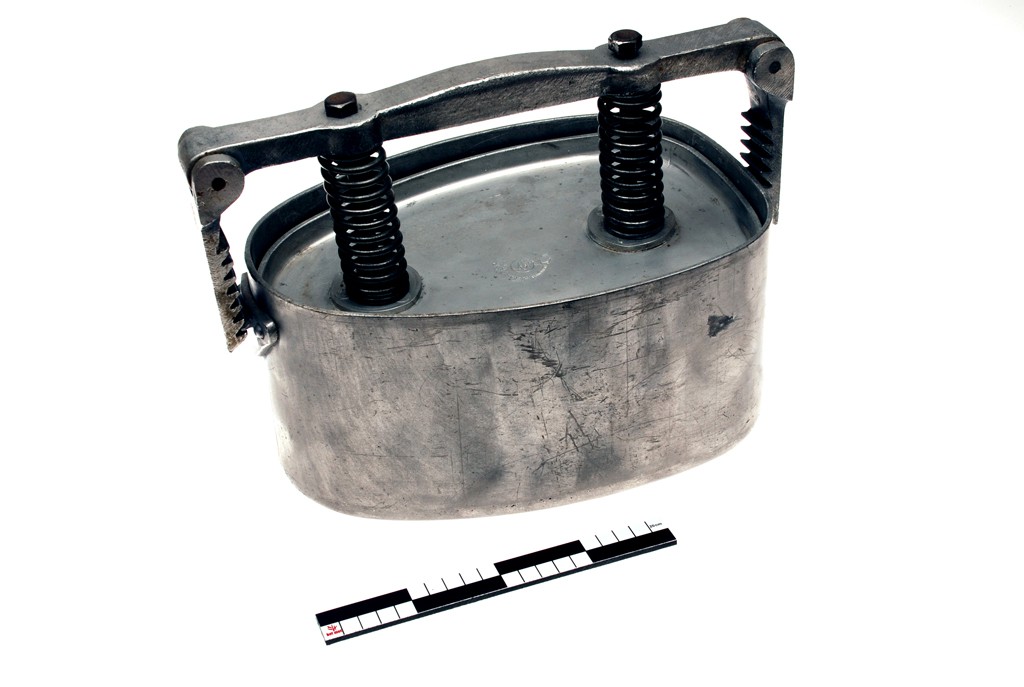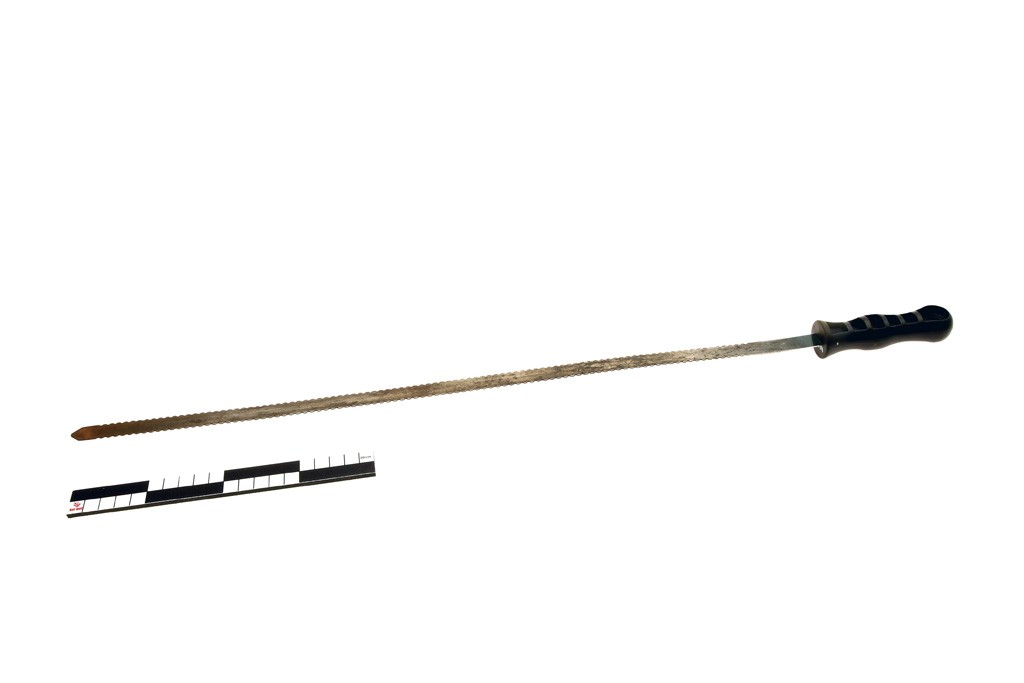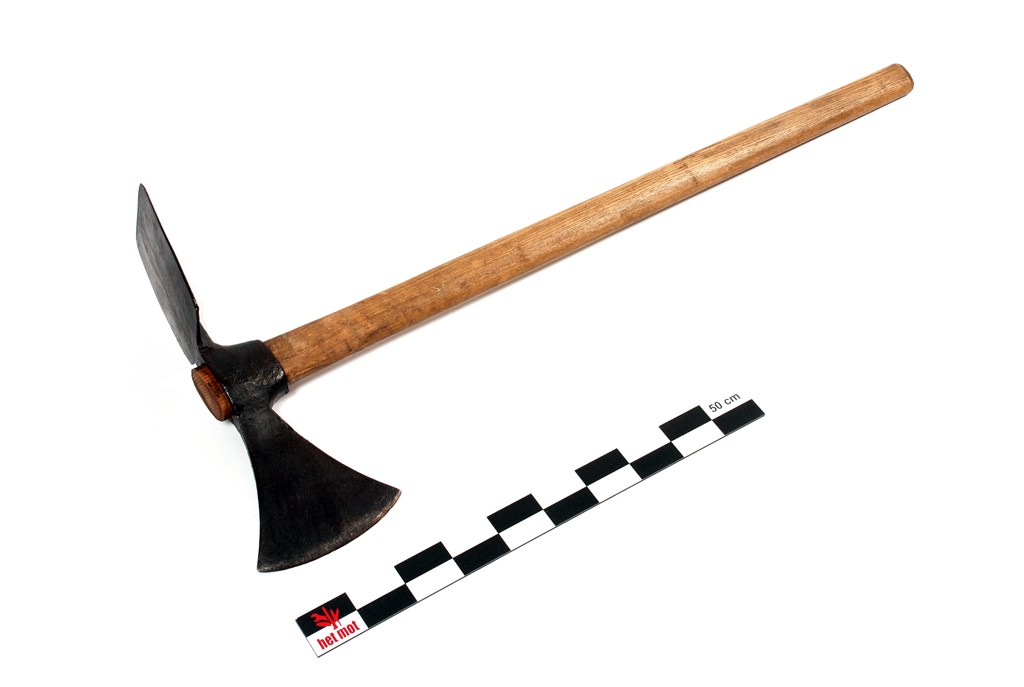ID-DOC: general search
Here you can enter a general keyword and perform a general search.
??? What are these question marks doing here? These represent tools which we know by a Dutch or French name, but who's English name is yet unknown. Suggestions are always welcome!
If you cannot find a certain tool, or if you experience other problems with this page, please let us know at info@mot.be.
Search for: tool
Showing search results 651 - 700
1,422 results found

Hairdresser's scissors
Light scissors (approx. 50 g), made entirely of metal - possibly with
plastic-covered arms - with triangular narrow (approx. 1 cm) blades, with
which the hairdresser cuts hair. The hairs are taken per strip between
index and middle fingers and cut to the desired length. The tailor also
uses such scissors to cut delicate fabrics such as lingerie. See also
thinning scissors. [MOT]

Halfmoon knife
The halfmoon knife is used by leatherworkers and in particular by the
saddler, to cut rigid leather to size. It has a semicircular blade (approx.
20 cm) and a straight handle attached exactly above the center of the
blade. With the medieval halfmoon knife, the handle is horizontal to the
top of the blade. You can make a long, beautiful cut with this knife, while
the hand exerts full pressure force. The angle of the halfmoon knife is
placed on the leather and according to the circumference of the knife, the
leather is cut through on the marked line. At the end point, the knife is
repositioned until the entire cut has been completed. Keeping the knife
horizontal, you cut into the thickness of the leather or bevel the edge.
[MOT]

Ham boner
The ham boner is a gouge to remove the thighbone or buttock of a ham or leg
of lamb without cutting open or damaging the meat (muscle tissue). It is a
sturdy gouge with a long (approx. 15-20 cm) and fairly wide (approx. 2-3
cm) blade that has a bevel on the outside, attached in a wooden or plastic
handle. The concave shape of the blade slides easily on the bone and the
bevel on the outside ensures that the meat comes off without much effort
and is damaged as little as possible. The working part is sometimes
slightly bent in length. See also the boning knife. [MOT]

Ham press
This text can only be consulted in Dutch
<https://www.mot.be/resource/Tool/600?lang=nl>

Ham slicer
With the ham slicer, pieces of ham are cut into very thin slices. It has a
narrow (approx. 1.5-2 cm) and long (approx. 25-30 cm) very flexible blade
with a rounded tip that cannot tear the thin slices. The cut can be smooth,
wavy or serrated. See also the carving knife. [MOT]

Ham trier
The smell is an important criterion when inspecting dried ham. The ham
trier (1) is used for this, an awl-shaped tool made from the fibula of a
horse, which is porous and therefore absorbs the odors. The horse bone is
inserted into the ham in certain places and the smell is then sniffed by
the inspector, who tastes the aromas of the ham in the throat. [MOT] (1)
SELLENS: 203 shows a hand tool with the same purpose but with a stem. The
material is not mentioned. No other English equivalent found. In French the
Latin word spilatula is used. Italians speak of 'ago d'osso di cavallo'.

Hammer drill (mechanical)
This text can only be consulted in Dutch
<https://www.mot.be/resource/Tool/hammer-drill-mechanical?lang=nl>

Hammer-axe

Hand bellows
This text can only be consulted in Dutch
<https://www.mot.be/resource/Tool/hand-bellows?lang=nl>

Hand brush
This text can only be consulted in Dutch
<https://www.mot.be/resource/Tool/hand-brush?lang=nl>

Hand can seamer
This text can only be consulted in Dutch
<https://www.mot.be/resource/Tool/hand-can-seamer?lang=nl>

Hand cultivator
Garden tool consisting of a usually 130-150 cm long (1) wooden handle with
three to five - but always in an odd number - curved iron teeth for opening
and turning the soil. The working part (approx. 10 to 25 cm wide) can be
fixed or exchangeable. In the latter case, you can choose the number of
teeth. The tips of the teeth are oval or triangular flattened. In contrast
to the garden hoe, with the hand cultivator the solid underlying soil, with
the sharp flat points and by its pulling movement, is slightly raised and
opened up. The middle tines of a hand cultivator are slightly shorter so
that the soil clod can be crumbled. To be distinguished from the grubber,
which is narrower and mainly serves to break the ground superficially. See
also the manual towed hand cultivator and hand wheel hoe. [MOT]

Hand drill
This text can only be consulted in Dutch
<https://www.mot.be/resource/Tool/hand-drill?lang=nl>

Hand harrow
The hand harrow is a small harrow that is pulled by one worker to loosen,
crumble and flatten the top layer of digged or plowed soil. It is also used
to work fertilizers and seeds into the soil. The hand harrow consists of a
wooden or iron, usually triangular, frame in which wooden or iron round,
square or diamond-shaped teeth (approx. 12-16 cm) protrude at an angle.
Sometimes the distance between the teeth is adjustable (1). Depending on
the slope and the direction of pull, the tines penetrate 1 to 7 cm deep
into the soil. The pull rope is attached to one corner of the frame. It is
pulled by means of a cross stick or a shoulder strap (2). See also soil
rake, rotary tiller (hand) and hoe with rake. [MOT] (1) Eg. Manufrance:
697. (2) Eg. Manufrance: 697.

Hand hook
Hand tool consisting of a square (approx. 1 cm), curved blade (approx. 6-8
cm long) in cross-section, ending in a pointed tip. It is attached at right
angles to a relatively long (approx. 25-35 cm) wooden handle, which widens
at the end. It is used for weeding between plants. See also the weeding
fork and moss scraper. [MOT]

Hand pincers
This text can only be consulted in Dutch
<https://www.mot.be/resource/Tool/hand-pincers?lang=nl>

Hand punch
This text can only be consulted in Dutch
<https://www.mot.be/resource/Tool/hand-punch?lang=nl>

Hand ratchet brace
This hand ratchet brace works on the same principle as the common brace but
has a lever instead of a U-shaped bracket. This lever works according to a
ratchet mechanism and can be moved with back and forth strokes. Where there
is no room for the normal brace, this type can be used. See also the
engineer's ratchet brace for metal. [MOT]

Hand ridger
This text can only be consulted in Dutch
<https://www.mot.be/resource/Tool/hand-ridger?lang=nl>

Hand seed drill
This text can only be consulted in Dutch
<https://www.mot.be/resource/Tool/hand-seed-drill?lang=nl>

Hand vice
This text can only be consulted in Dutch
<https://www.mot.be/resource/Tool/hand-vice?lang=nl>

Hand wheel hoe
In crops growing in rows, the roots of weeds are cut with the hand wheel
hoe; they are sometimes also used to break the crust so that a better air
circulation is created and to counteract the capillary effect - and thus
the drying out. The hand wheel hoe usually consists of two metal wheels
(diam. Approx. 35 cm), each with a rod on the axle that keeps a metal
plate, just behind the wheel, at the correct height. Both trapezoidal
plates, connected by a bracket, are provided with 2-3 slots into which the
oblique knives or hoes can be screwed to the desired width. The whole is
pushed in front of you by means of two wooden arms (approx. 130 cm). There
are also hand wheel hoes with one wheel with which you can hoe between two
rows of plants, as opposed to the model with two wheels, which works on
both sides of one row of plants. Nowadays there is a model with a rubber
wheel (approx. Diam. 25-60 cm) where the hoes can be replaced by the blade
of a hand ridger or hand cultivator (1). [MOT] (1)...

Handbagger
After the plants and grass from the ditch side have been mowed, the (small)
ditches are manually cleared of sludge and dirt that impedes the water
flow. The tool also serves to dredge ponds and other water features. The
cleaning of the ditches is done at low tide, after a period of drought. One
starts at the lowest point and against the current. More technical
information on the dutch version of this tool page. See also the drag-net.
[MOT]

Handcarder
This text can only be consulted in Dutch
<https://www.mot.be/resource/Tool/handcarder?lang=nl>

Handsaw
This text can only be consulted in Dutch
<https://www.mot.be/resource/Tool/handsaw?lang=nl>

Handsaw for aerated concrete
Cellular, foam or aerated concrete is a concrete product with gas bubbles
in it, making the material light, strong and easy to work with with the
aerated concrete handsaw and with the stonemason's French drag. The aerated
concrete handsaw has a thick (approx. 1.5 mm) tapered blade (approx. 50-70
cm). The large carbide (widia) teeth (30-40) are angled forward, so they
saw when pushing the tool. See also the handsaw. [MOT]

Handspike
Wooden lever (1.5 to 2 meters long) clad with metal fittings at the bottom,
to lift heavy loads to a small height. Railroad workers use them to
separate railroad tracks. Quarry workers such as the stonecutter use a
handspike to place stone blocks on rollers. This tool can be distinguished
from the crow bar and the ripping chisel. [MOT]

Hardie
This text can only be consulted in Dutch
<https://www.mot.be/resource/Tool/hardie?lang=nl>

Hat brush
This text can only be consulted in Dutch
<https://www.mot.be/resource/Tool/hat-brush?lang=nl>

Hawk
This text can only be consulted in Dutch
<https://www.mot.be/resource/Tool/893?lang=nl>

Hay fork / bundle fork
The hay fork is a fork with 2 to 3 - sometimes four - round or square,
pointed, slightly curved, iron or steel tines (approx. 15-30 cm; spacing:
approx. 7-20 cm), which have a straight wooden handle of varying length
(approx. 100-300 cm). Sometimes it is also a monoxil fork-shaped branch
(1). The farmer prefers a steel hay fork with two tines, to put the sheaves
on the cart at harvest time or to stick it from the cart in the attic. The
one with three teeth or the wooden bundle fork is often used to turn the
hay (see also the hay rake). There is also a double model with a row of 3
tines at the bottom and a row of 2 tines at the top to collect the hay into
bales. [MOT] (1) Eg. ROBERT: 8-20.

Hay hook
Hand tool used by the farmer to move bales of straw. It is a hook-shaped
iron with a ring as a handle. Distinguishable from the cotton hook which is
lighter and usually shorter. [MOT]

Hay knife
The hay knife has a 50 to 100 cm long blade with cut, which can be
serrated; when teeth are present, it is called a hay saw. Both the knife
and the saw serve to cut compressed hay, but also manure or silage forage,
into pieces with a vertical movement. [MOT]

Hay rake
This text can only be consulted in Dutch
<https://www.mot.be/resource/Tool/hay-rake?lang=nl>

Hay spade
With a hay spade (1) you can cut off strongly compressed hay (see also hay
knife). Afterwards it can be processed further with the hay fork. The hay
spade is to be distinguished from the flauchter spade. [MOT] (1) proper
name unknown.

Hay thief
The hay thief is used to pull a tuft of hay from the interior of a haystack
or the hayloft. That sample can then be examined for condition and quality.
After all, it is important to check whether the hay inside is dry, both for
the nutritional value and for safety (self-ignition). The hay thief usually
consists (1) of an iron rod (approx. 30 cm) ending in a point and fitted
with a barb with a slightly curved point at approx. 5 cm from the end (2).
The straight wooden stem measures approx. 80 cm. Sometimes the tool is made
entirely of iron and the rod ends in an eye (3). [MOT] (1) According to
DAVID 1973: 25 there are also completely wooden hay hooks. (2) SELLENS: 233
states that a hay thief can count two or more hooks. (3) Eg. DEVLIEGHER:
82.

Head knife
This text can only be consulted in Dutch
<https://www.mot.be/resource/Tool/head-knife?lang=nl>

Heat exchanger cleaning knife
This text can only be consulted in Dutch
<https://www.mot.be/resource/Tool/heat-exchanger-cleaning-knife?lang=nl>

Hedge shears
This text can only be consulted in Dutch
<https://www.mot.be/resource/Tool/hedge-shears?lang=nl>

Hinge chisel
This text can only be consulted in Dutch
<https://www.mot.be/resource/Tool/hinge-chisel?lang=nl>

Hoe
Agricultural and horticultural tool with a rectangular, semicircular,
triangular or heart-shaped blade that lies diagonally opposite the wooden
straight handle. The angle between blade and stem varies from 30 ° to 80 °.
The blade can be covered with wood or iron. Usually the stem is half long
(approx. 100-120 cm) and the hoe is used standing; however, there are also
hoes with a shorter handle (approx. 50-60 cm) that require you to bend down
or get on your knees (1). Dimensions and weight vary greatly and are
adapted to the destination. For example, chopping is used to work the soil,
to ridge potatoes (see also hand ridger), to harvest potatoes (see also
potato lifting fork and potato harvester), plant trees, dig trenches, etc.
Osiers and meadow farmers deepen and widen the trenches after each harvest
(see this osier worker's tool) with a hoe. The handle (approx. 1 to 2 m)
and blade are connected here by means of a D-shaped ring, a spring and a
bolt. The cut is slightly curved. In the...

Hoe axe
This text can only be consulted in Dutch
<https://www.mot.be/resource/Tool/hoe-axe?lang=nl>

Hog ring pliers
This text can only be consulted in Dutch
<https://www.mot.be/resource/Tool/kramtang?lang=nl>

Hollow auger
This text can only be consulted in Dutch. [MOT]

Honey dipper
This text can only be consulted in Dutch
<https://www.mot.be/resource/Tool/honey-dipper?lang=nl>

Honey strainer
This text can only be consulted in Dutch
<https://www.mot.be/resource/Tool/honey-strainer?lang=nl>

Hoof cleaning knife
Hand tool that the blacksmith uses to trim horses' hooves. It usually has a
slightly curved blade that is bent at the end and that cuts its entire
length. (Compare with the beam scribe, the timber scribe, the cooper's
timber scribe and the clog maker's timber scribe). That blade sticks in a
wooden handle that is often bent upwards. Excess horn is cut away with the
knife. With the bent end - which also cuts - impurities on the inside of
the hoof can be removed. There are models for both left and right-handed
users (1). See also the horseman's folding knife. [MOT] (1) Eg.
Encyclopédie 1740-80, volume 13: s.v. Marechal ferrant.

Hoof nipper
This text can only be consulted in Dutch
<https://www.mot.be/resource/Tool/hoof-nipper?lang=nl>

Hoof tester
Pliers with which the farrier examines sick, painful hooves. Pain can arise
in the hoof because changes in shape of the horny parts exert a pressure on
the parts located therein and because internal parts of the hoof are
swollen and therefore exert direct pressure on the nerves of the hoof.The
hoof tester is a fairly large pair of tongs (approx. 30-40 cm long) with a
jaw that can open wide so that the hoof can between them. The jaws are
rectangular or round in cross section and have studs on the end. The
different parts of the hoof are pinched with the forceps; Based on the
reaction of the horse, one can determine the painful place. [MOT]

Hoofpick
The hoofpick is an iron or plastic hook (approx. 15 cm long) that removes
dirt from the hooves of a horse. The hand tool is often combined with a
stud tap or a brush, sometimes whit a ring spanner. It is often part of the
horseman's folding knife. [MOT]
